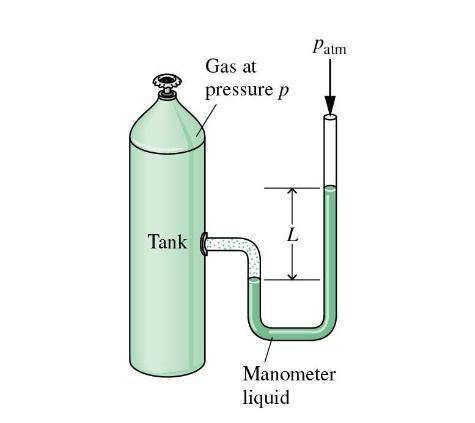
Engineering, 12.02.2021 01:00 izzyisawesome5232
As shown in the figure below, a monometer is attached to a tank of gas in which the pressure is 104.0 kPa. The manometer liquid is mercury, with a density of 13.59 g/cm 3 . If g = 9.81 m/s 2 and the atmospheric pressure is 101.33 kPa, calculate (a) the difference in mercury levels in the manometer, in cm, and (b) the gage pressure of the gas, in kPa.


Answers: 3


Another question on Engineering

Engineering, 04.07.2019 18:10
Manometers are good examples of measuring instruments, nowadays they are not as common as before. a)-capacitive probe gauges b)-gravitational gauges deformation ) gauges d)-digital gauges
Answers: 1

Engineering, 04.07.2019 18:20
A3-mm-thick panel of aluminum alloy (k 177 w/m-k, c 875 j/kg-k and ? = 2770 kg/m) is finished on both sides with an epoxy coating that must be cured at or above t,-150°c for at least 5 min. the production line for the curing operation involves two steps: (1) heating in a large oven with air at ts,0-175°c and a convection coefficient of h, 40 w/m2. k, and (2) cooling in a large chamber with air at 25°c and a con- vection coefficient of he 10 w/m2.k. the heating portion of the process is conducted over a time interval te which exceeds the ime required to reach 150°c by 5 min (h = r + 300 s). the coating has an emissivity of ? = 0.8, and the temperatures of the oven and chamber walls are 175 and 25°c, respectively. if the panel is placed in the oven at an initial temperature of 25°c and removed from the chamber at a safe-to-touch tempera ture of 37°c, what is the total elapsed time for the two-step curing operation?
Answers: 3

Engineering, 04.07.2019 19:20
At steady state, air at 200 kpa, 325 k, and mass flow rate of 0.5 kg/s enters an insulated duct having differing inlet and exit cross-sectional areas. the inlet cross-sectional area is 6 cm2. at the duct exit, the pressure of the air is 100 kpa and the velocity is 250 m/s. neglecting potential energy effects and modeling air as an 1.008 kj/kg k, determine ideal gas with constant cp = (a) the velocity of the air at the inlet, in m/s. (b) the temperature of the air at the exit, in k. (c) the exit cross-sectional area, in cm2
Answers: 2

Engineering, 04.07.2019 19:20
Acommercial grade cubical freezer, 4 m on a side, has a composite wall consisting of an exterior sheet of 5.0-mm thick plain carbon steel (kst= 60.5 w/m k), an intermediate layer of 100-mm thick polyurethane insulation (kins 0.02 w/m k), and an inner sheet of 5.0- mm thick aluminium alloy (kal polyurethane insulation and both metallic sheets are each characterized by a thermal contact resistance of r 2.5 x 104 m2 k/w. (a) what is the steady-state cooling load that must be maintained by the refrigerator under conditions for which the outer and inner surface temperatures are 25°c and -5°c, respectively? (b) for power saving purpose, which wall material should be increased/reduced in. thickness in order to reduce 50% of the cooling load found in part (a)? redesign the thickness of the proposed material. 177 w/m-k). adhesive interfaces between the q=575.93 w
Answers: 2
You know the right answer?
As shown in the figure below, a monometer is attached to a tank of gas in which the pressure is 104....
Questions

English, 14.04.2020 01:40

Computers and Technology, 14.04.2020 01:40

Mathematics, 14.04.2020 01:40

Mathematics, 14.04.2020 01:40


Biology, 14.04.2020 01:40

Biology, 14.04.2020 01:40


Mathematics, 14.04.2020 01:40



Social Studies, 14.04.2020 01:40


Mathematics, 14.04.2020 01:40

Mathematics, 14.04.2020 01:40


Mathematics, 14.04.2020 01:40


Mathematics, 14.04.2020 01:40

Mathematics, 14.04.2020 01:40

 ) and atmospheric pressure (
) and atmospheric pressure ( ), both measured in pascals. A kilopascal equals 1000 pascals and 1 meter equals 100 centimeters. That is:
), both measured in pascals. A kilopascal equals 1000 pascals and 1 meter equals 100 centimeters. That is:  (1)
(1) - Density of mercury, measured in kilograms per cubic meter.
- Density of mercury, measured in kilograms per cubic meter. - Gravitational acceleration, measured in meters per square second.
- Gravitational acceleration, measured in meters per square second. - Difference in mercury levels, measured in meters.
- Difference in mercury levels, measured in meters.  ,
,  ,
,  and
and  , the difference in mercury levels in the manometer is:
, the difference in mercury levels in the manometer is:



 (2)
(2)




